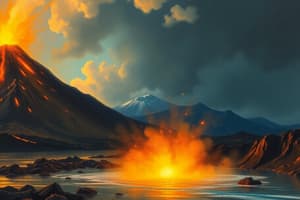Podcast
Questions and Answers
Explain how the viscosity of magma affects the explosiveness of a volcanic eruption.
Explain how the viscosity of magma affects the explosiveness of a volcanic eruption.
High viscosity magma traps gases, leading to increased pressure and explosive eruptions. Low viscosity magma allows gases to escape more easily, resulting in effusive eruptions.
Describe two potential benefits and two potential hazards of volcanic activity.
Describe two potential benefits and two potential hazards of volcanic activity.
Benefits: fertile soils from volcanic ash, geothermal energy. Hazards: lahars, ashfall disrupting air travel.
How do ocean currents influence regional climates, and what factors drive these currents?
How do ocean currents influence regional climates, and what factors drive these currents?
Ocean currents redistribute heat around the globe, warming some regions and cooling others. They are driven by wind, temperature, salinity, and Earth's rotation.
Explain how the angle at which the sun's rays strike Earth's surface affects temperature and climate.
Explain how the angle at which the sun's rays strike Earth's surface affects temperature and climate.
Describe how being on the windward side of a mountain range affects the local climate, and what is the process called that causes this effect?
Describe how being on the windward side of a mountain range affects the local climate, and what is the process called that causes this effect?
Flashcards
Volcano
Volcano
A geological formation where molten rock, ash, and gases escape from below the Earth's surface.
Types of Volcanoes
Types of Volcanoes
Classifications of volcanoes based on their shape and eruptive behavior, e.g., shield, stratovolcano, and cinder cone.
Volcanic Eruptions
Volcanic Eruptions
The release of gas, ash, and molten rock from a volcano, which can be explosive or effusive.
Climate Change
Climate Change
Signup and view all the flashcards
Ocean Currents
Ocean Currents
Signup and view all the flashcards
Study Notes
Unit 3: Earth and Space
- Module 1: Volcanoes
- Overview
- Pre-assessment: What is a Volcano?
- Activity 1: Volcano Concept Map
- Activity 2: Volcanoes in the Philippines
- Activity 3: Under Pressure
- Activity 4: Viscosity Race
- Activity 5: In and Out
- Types of Volcanic Eruptions
- Energy from the Volcano
- Sign of an Impending Volcanic Eruption
- Enrichment Activity
- Summative Assessment
Module 2: Climate
- Overview
- Pre-assessment
- Activity 1: When the Sun's Rays Strike
- Activity 2: The Higher, the Colder
- Activity 3: Which Cools and Heats Faster?
- Activity 4: Which Should I Choose, Windward or Leeward?
- Activity 5: Temperatures of Different Cities Around the World
- Activity 6: Ocean Currents
- Climate Change
- Activity 7: Getting Ready!
- Activity 8: It's Gettin' Hot in Here
Studying That Suits You
Use AI to generate personalized quizzes and flashcards to suit your learning preferences.




